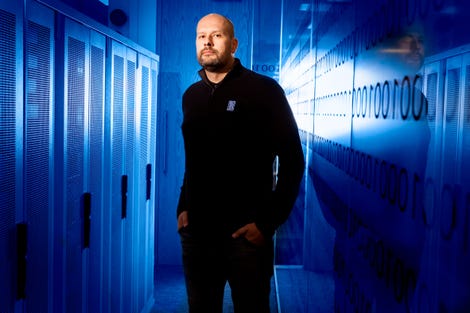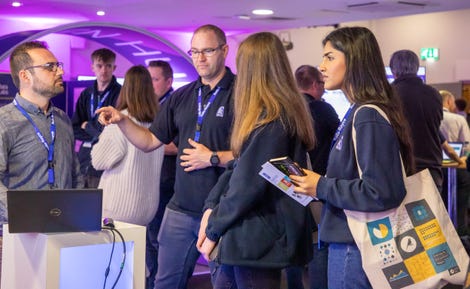Rolls-Royce has created a digital showroom to show the benefits of low-code development. Rolls Royce
Low-code platforms democratize application development and give all kinds of professionals the ability to create their own software solutions to meet the challenges they face. Such is the case at engineering giant Rolls-Royce, where chief digital and information officer Stuart Hughes oversaw the implementation of the Microsoft Power Apps platform.
The British aerospace and defense giant is working with Microsoft to help its staff adopt low-code techniques and create tools for productivity and research and development.
Additionally, Stuart Hughes expects more and more people in the company to start developing their own apps. “The way we work with the Microsoft Office suite today is exactly the way we will work with the Power platform in the future,” he explains. “I think it’s a very powerful productivity tool for our employees.”
“Micro-innovations” but real return on investment
Some of the low-code apps that have been developed so far include a 24/7 on-call system for the company’s research and development department, a Kudos app, and a analytical edge that helps visualize important information.
Mr Hughes calls these applications “micro-innovations” and estimates that the benefits from these small improvements will be between €9 and €11 million in terms of profitability and savings in 2022.
And recent studies show that Rolls-Royce is far from being the only one to turn to this type of tool. According to Gartner, organizations of all kinds are increasingly turning to low-code technologies to meet the growing demand for rapid application delivery and personalized workflows. The analyst says global low-code development spending will reach $26.9 billion in 2023, a 19.6% increase from 2022.

Hughes on Microsoft Power Apps: “I think it’s a very powerful productivity tool for our employees.” Rolls Royce
“It’s one more tool”
Gartner also predicts that non-CIO developers will make up at least 80% of the low-code development tools user base by 2026, up from 60% in 2021.
With enterprise employees increasingly comfortable taking on application development, is low code/no code the future of software building?
“It’s just one more tool,” replies Hughes, who suggests that services like Microsoft Power Apps should be considered an important weapon in the arsenal of tools companies can use to fuel their digital transformation efforts. This change is important because the IT teams within the DSI are under enormous pressure. Studies show that more than half (56%) of CIO employees say their role is becoming more stressful every year.
Reduce pressure on IT departments
Rolls-Royce recognizes that the ever-increasing demand for digital transformation means that it would be nearly impossible for the IT team to complete an endless to-do-list.
So while some IT professionals might view the rise of low-code development as a threat to themselves, Hughes believes that no-code tools give large companies the ability to create small, targeted solutions that are much more quickly. “It’s about using people who have the skills to do the most useful work they can do,” he explains.
Low-code techniques free up Rolls-Royce developers to focus on higher value tasks, including ensuring that effective governance is in place to transform smart ideas into products.
“It allows our IT team to govern,” says Hughes. “It gives us more space to innovate. It allows us to find changes to our business systems that will replace some of these applications as things start to mature.”
For Rolls-Royce, low-code development is therefore a way to reduce the pressure on IT departments while providing a source of fresh and innovative ideas and applications. And while the company has already had some big successes with its low-code development strategy, it’s also looking to do much, much more.
Go to data science
She recently organized a “Citizen Digital Expo”, which was attended by 500 colleagues from across the company. Low-code developers were assigned a booth at the Expo, where they could show how their application works and where interested parties could discuss how the tool could be applied in their industry. ‘activity. The event was good for reuse: people saw things and thought, ‘I wish I had one like that,'” says Stuart Hughes.

No less than 500 people from all areas of the company visited the digital exhibition. Rolls Royce
In fact, Rolls-Royce makes it easier for other in-house developers to access and use low-code software. The company has an internal app store where employees can go see if someone else has developed software that helps them meet their business needs.
There is also an online community on Yammer and Teams that allows company employees to discuss low-code techniques and applications in development. For those who want to get hands-on, Rolls-Royce offers four-day Microsoft training courses.
Hughes’ team has also created an internal guide to help employees get started with Power Apps and is working with “super users” across the company to raise awareness of the benefits of the “low-code” approach and share best practice techniques.
Mr. Hughes thinks the Power platform can still bring other advantages – and he underlines his desire to train data scientists who do not necessarily have the useful background for this function. “I really believe that everything we do is getting closer to that,” he says. “With data science, you can unlock a lot of value.”
However, Mr. Hughes believes that getting to this stage will not be easy. For now, low-code tools are still very focused on IT department activities. However, he believes that the shift to data science will happen in the not too distant future.
“All the data needs to be in one place and clean,” he explains. “But I think the opportunity to harness the power of big data and data science will materialize in the next five years. And I think that will give a new impetus to digital transformation.”
Hughes expects low-code technology to act as a “co-pilot”, working hand-in-hand with employees to achieve goals. “It will help them do their job better,” he says. “I think we’re going to see people doing more with data, more people in roles that involve data analysis, and we hope to be able to democratize the fields of data science and machine learning. , just as we have already democratized some elements of the software development process.
Source: “ZDNet.com”
